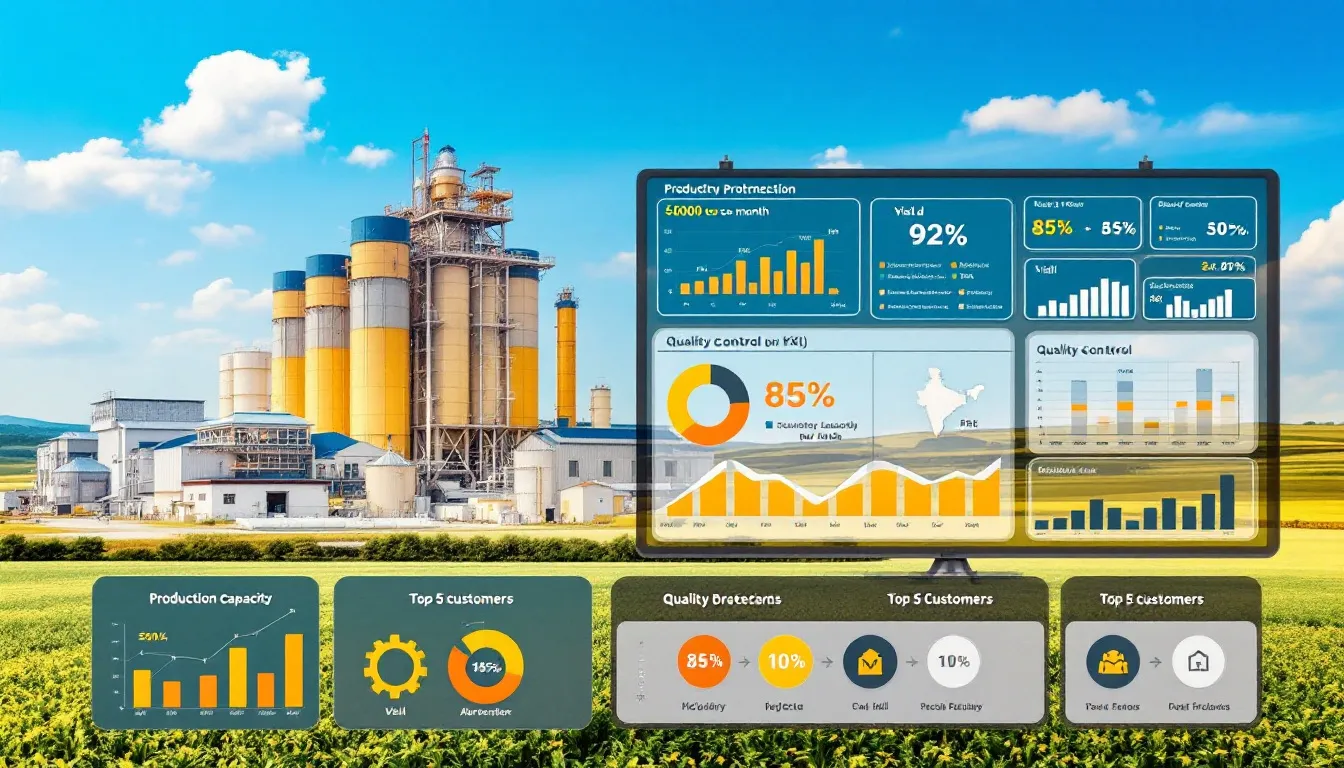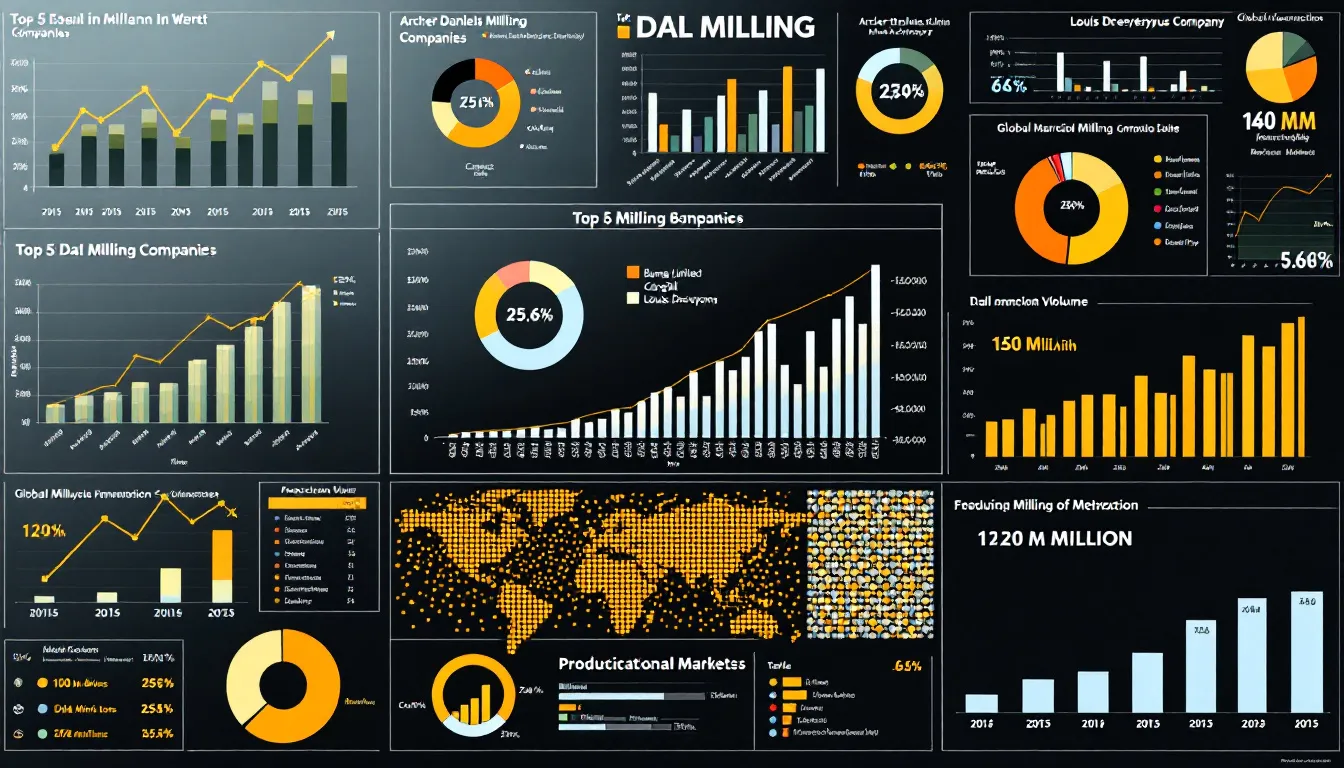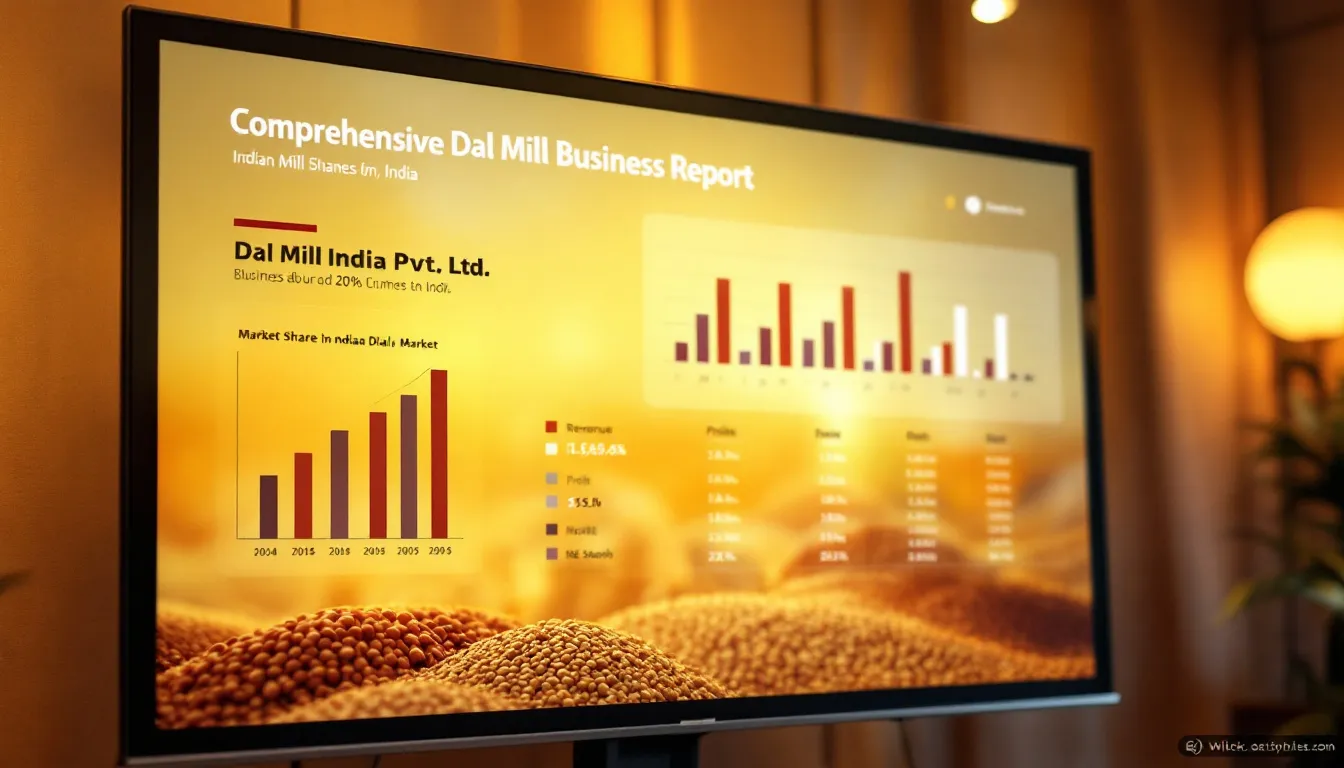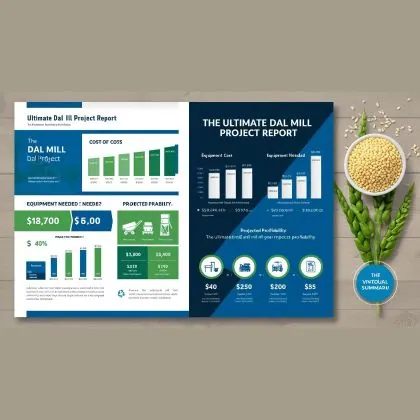Description
To start a dal mill or dall mill, you need to grasp the costs, required equipment, and potential profitability. This dal mill project report provides a detailed guide to help you understand these critical elements and successfully launch your venture.
Key Takeaways
Table of Contents
- 1 Key Takeaways
- 2 Overview of Dal Mill Business
- 3 Project Report Essentials
- 4 Market Analysis
- 5 Financial Projections
- 6 Equipment and Machinery Requirements
- 7 Raw Materials Procurement
- 8 Manufacturing Process
- 9 Location and Space Considerations
- 10 Licensing and Registration
- 11 Marketing Strategy
- 12 Marketing Strategy
- 13 Risk Management
- 14 Sustainability Practices
- 15 Profitability Analysis
- 16 How to Prepare a Project Report for Dal Mill Business in India
- 17 Why Buy Our Project Report?
- 18 Summary
- 19 Frequently Asked Questions
- Dal milling is a vital sector in India, transforming raw pulses into nutritious, convenient products while bolstering the agricultural market.
- A detailed project report is essential for starting a dal mill, encapsulating operational plans, financial projections, and securing necessary licenses.
- Sustainable practices and effective marketing strategies are key to enhancing profitability and resilience in the competitive dal milling market.
Overview of Dal Mill Business

Dal milling holds a prestigious position as the third largest food grains processing business in India, underscoring its significance in the food industry. This sector plays a vital role in the Indian diet, with milled dal and pulses like moong, lentil, and urad being staple ingredients in daily meals.
The process of dal milling transforms raw pulses into edible forms, making them more convenient for consumption. This transformation not only enhances the nutritional value of pulses but also adds value to the agricultural sector by providing a steady market for pulse farmers.
Understanding the importance of this business is the first step towards venturing into the dal milling industry.
Project Report Essentials
A detailed project report is foundational for starting a dal milling business. It serves multiple purposes, such as securing funding and setting up operations correctly. The report includes an executive summary covering the project’s goals, financial viability, and expected profitability. Fixed capital is crucial in the financial projections and overall investment for the dal mill project, as it covers the costs associated with fixed assets and is essential alongside working capital.
The business model and objectives section outlines the types of pulses to be processed, market and revenue targets, and the overall business strategy. Financial projections should consider funding and operating expenses. Government initiatives, such as subsidies and research support, can significantly boost the dal milling market, fostering growth.
Market Analysis

- Significance in Indian Diets: Pulses are a crucial protein source in Indian diets, with India being the largest global producer, creating a vast market for processed pulses.
- Impact of Urbanization: Urbanization and the shift towards convenience foods have driven an increasing demand for processed pulses, significantly impacting the growth of the dal milling sector.
- Industry Importance: Approximately 75% of India’s pulse production is processed into dal, underscoring the industry’s importance.
- Market Growth Projection: The dal milling market in the Asia Pacific is projected to reach approximately USD 1.85 billion by 2032, fueled by high pulse consumption in countries like India and China.
- Popularity of Chana Dal: Chana dal, which constitutes nearly 30% of the market, is the most popular due to its versatile culinary applications.
- Adapting to Trends: Staying informed about market trends and consumer preferences is vital for adapting product offerings and maintaining competitiveness.
Financial Projections

A comprehensive financial plan is crucial for any business venture. For a dal mill, the initial investment typically includes costs for land, machinery, and raw materials, totaling around ₹30,00,000. Annual operating costs can reach approximately ₹9,50,000, covering labor, utilities, and raw materials.
When starting a dal mill, one option to consider is to borrow money from banks. Proper financial planning is essential, and securing collateral can help in obtaining the necessary funding for the project.
The expected annual revenue from a dal mill is around ₹12,00,000, based on a production volume of 20,000 kg of dal at an average selling price of ₹60 per kg. Effective management can lead a dal mill to achieve a net profit of approximately ₹2,50,000 per year, with the break-even point typically attainable within two years.
Investing in sustainable practices, such as energy-efficient machinery, may incur upfront costs but can lead to long-term savings on energy and waste management. Insurance coverage for equipment and facilities safeguards against unexpected losses due to accidents or natural disasters.
Equipment and Machinery Requirements
- Modernized Machinery: Setting up a dal mill requires precise and modern machinery to ensure efficient operations and high-quality output.
- Essential Equipment:
- Emery Rollers: Used for efficient dal milling operations, ensuring the proper dehusking and splitting of pulses.
- Bucket Elevators: Facilitate the vertical transportation of bulk materials within the mill, improving workflow and reducing manual labor.
- Reel Machines: Essential for effective grain cleaning, removing impurities and ensuring the quality of the final product.
- Cost and Efficiency Considerations: The cost and efficiency of equipment can vary based on production volume and the type of dal being processed. Selecting the right machinery is crucial for optimizing production and minimizing costs.
- Electric Dal Mill Machines: These are gaining popularity due to their energy efficiency and lower maintenance costs, making them a smart investment for long-term savings.
- Technological Advancements: Integration of IoT and AI technologies is enhancing operational efficiency and productivity, allowing for better monitoring and control of the milling process.
- Reliable Sources: For small scale production technology, reliable sources include government bodies and academic institutions, which can provide guidance and support in selecting and utilizing the appropriate machinery.
Raw Materials Procurement
- Primary Ingredient: The core raw materials required for dal milling are various types of pulses, including moong, lentil, and urad, among others.
- Local Partnerships: Establishing partnerships with local farmers is crucial for ensuring a steady and regular supply of high-quality pulses.
- Quality Assurance: Regular quality checks on sourced pulses are essential to maintain high product standards and ensure customer satisfaction.
- Logistical Considerations: Adequate storage space is necessary to manage bulk purchases of raw materials during the harvesting season.
- Reliable Supply Chain: Building a reliable supply chain by maintaining strong relationships with regional pulse farmers is key to successful operations.
- Sourcing Strategy: Contacting and collaborating with regional pulse farmers can help secure a consistent and dependable supply of raw materials.
Manufacturing Process
- Cleaning: The manufacturing process begins with cleaning the raw pulses to remove impurities such as dust, stones, and other foreign materials, ensuring the quality of the final product.
- Dehusking: The next step involves dehusking, where the outer layer of the pulse is removed. This is crucial for transforming raw pulses into edible forms.
- Milling: After dehusking, the pulses are milled to split them into smaller, edible pieces. This step is essential for producing different varieties of dal, catering to diverse consumer preferences.
- Polishing: Polishing enhances the appearance and consumer appeal of the dal, adding value through a refined finish that attracts customers.
- Quality Control: Throughout the process, quality assurance is maintained to ensure the final product meets industry standards and customer expectations.
- Packaging: The final step is packaging, which protects the dal during distribution and ensures it reaches consumers in optimal condition.
- Storage: Proper storage plans are implemented to maintain the quality of both raw materials and finished products, ensuring a regular supply to meet market demand.
Utilizing modern and reliable milling equipment is crucial for achieving optimal results and maintaining efficiency in the dal processing operation.
Location and Space Considerations
Strategic Site Selection: Choose a location in a secure industrial area to ensure operational safety and compliance with regulations. West Bengal is a key region for dal processing before distribution to other areas, making it a strategic choice for setting up a dal mill.
Transportation Access: Ensure easy access to major transportation routes to facilitate efficient supply chain management and distribution.
Storage Facilities: Plan for adequate storage space to handle bulk purchases of raw pulses and store finished products safely.
Operational Efficiency: Allocate sufficient space for various operational components, including machinery, packaging, and quality control areas, to ensure smooth workflow.
Scalability: Consider future expansion possibilities by selecting a location that can accommodate growth in production capacity.
Utilities Availability: Ensure the site has reliable access to essential utilities like electricity and water, crucial for uninterrupted operations.
Licensing and Registration
- FSSAI Registration: Mandatory for ensuring food safety standards, crucial for operating a dal mill business.
- GST Number: Essential for taxation purposes, enabling smooth financial transactions and compliance.
- Trade License: Required, especially for sole proprietorships, to legally operate the dal milling business.
- Local Government Licenses: Necessary to comply with regional regulations and ensure legal business operations.
- ESI and EPF Registrations: Important for employee benefits, ensuring compliance with labor laws.
- Pollution Control Board Clearance: Required to meet environmental regulations and ensure sustainable operations.
Completing these registrations ensures legal compliance and facilitates smooth business operations.
Marketing Strategy

Marketing Strategy
- Channel Marketing: Utilize various sales channels such as retail, wholesale, and exporting to effectively reach diverse market segments and maximize customer reach.
- Brand Identity: Develop a strong and unique brand identity to stand out in the competitive dal market. This helps in building customer loyalty and recognition.
- Product Diversification: Offer a wide range of dal varieties, such as Masoor dal, Green moong dal, and Tur dal, to cater to different consumer preferences and reduce market risk.
- International Market Opportunities: Leverage the strong international market for dal products by targeting major pulse-producing countries like Canada, Brazil, China, Myanmar, the United States, and Mexico.
- Farmer Relationships: Build strong relationships with local farmers to ensure a consistent and high-quality supply of raw materials, enhancing product reliability.
- Consumer Trends: Stay informed about consumer trends and preferences to adapt product offerings and maintain competitiveness in the market.
- Marketing Campaigns: Implement targeted marketing campaigns to raise brand awareness and promote the nutritional benefits of dal products.
- Online Presence: Establish a robust online presence through social media and e-commerce platforms to reach a wider audience and facilitate direct consumer engagement.
- Collaborations and Partnerships: Form strategic collaborations and partnerships with retailers and distributors to expand market reach and distribution networks.
- Customer Feedback: Regularly gather and analyze customer feedback to improve product offerings and customer satisfaction, fostering long-term business success.
Risk Management
- Identify Potential Risks: Recognize challenges in supply chain, operations, and market dynamics to proactively address them.
- Develop Mitigation Strategies: Formulate strategies to counter identified risks, ensuring business continuity and resilience.
- Implement Quality Control: Establish strict quality control measures to maintain product consistency and customer satisfaction.
- Regular Risk Reviews: Continuously assess and update risk management strategies to stay competitive and responsive to market changes.
- Enhance Operational Resilience: Effective risk management safeguards against unforeseen challenges, bolstering the business’s ability to adapt.
- Leverage Technology: Utilize technology to monitor and manage risks effectively, improving overall operational efficiency.
Sustainability Practices
Sustainable practices in dal milling benefit both the environment and the business. Implementing energy-efficient machinery can lower electricity usage and reduce operational costs. Technological advancements in the milling process enhance efficiency while minimizing waste and energy use.
Innovative use of by-products like husks and bran can convert waste into valuable resources, enhancing sustainability. Adopting water-saving technologies, like closed-loop systems, aids in conserving water and ensuring compliance with environmental standards.
Sustainable practices not only improve product quality but also appeal to eco-conscious consumers.
Profitability Analysis
Profitability in the dal milling business can be influenced by various factors. Profit margins for mini dal mills typically range between 20% and 30%, depending on operational efficiency and market demand. Efficient production processes and strong supplier relationships can enhance profit margins.
Offering value-added products, like specialty lentils or packaged dal, can significantly improve profit margins. A well-prepared project report, including financial projections, can help secure loans and attract investors by demonstrating the business’s potential.
How to Prepare a Project Report for Dal Mill Business in India

- Executive Summary: Begin with a concise summary of the project, outlining the objectives, scope, and potential benefits of the dal mill business.
- Business Model: Detail the business model, including the types of pulses to be processed, target markets, and revenue streams.
- Market Analysis: Conduct a thorough market analysis to assess demand for different varieties of dal, focusing on regional consumption patterns and market gaps.
- Milling Process Overview: Describe the entire milling process, from cleaning and dehusking to milling and packaging, emphasizing efficiency and quality assurance.
- Financial Projections: Provide detailed financial projections, including initial investment requirements, operating costs, and expected revenue, to demonstrate the business’s viability.
- Regulatory Requirements: List necessary licenses and registrations, such as FSSAI registration, GST number, and trade licenses, ensuring compliance with local regulations.
- Risk Analysis: Identify potential risks and develop mitigation strategies to enhance business resilience and sustainability.
- Sustainability Practices: Highlight sustainable practices, such as energy-efficient machinery and waste reduction, to improve operational efficiency and appeal to eco-conscious consumers.
- Marketing Strategy: Outline a comprehensive marketing strategy, including branding, product diversification, and sales channels, to effectively reach target customers.
- Conclusion: Summarize the strategic plan, emphasizing the business’s potential for growth and profitability, and the steps necessary to achieve these goals.
Why Buy Our Project Report?
- Clear Business Objectives: Our project report clearly defines business objectives, providing a solid foundation for your dal mill venture.
- Market Insights: Gain a comprehensive understanding of the market and technology involved in setting up a dal mill, helping you make informed decisions.
- Financial Analysis: Our report includes detailed financial analysis and feasibility studies, crucial for attracting investors and securing funding.
- Regulatory Compliance: Ensure compliance with regulatory requirements, streamlining the setup process and enhancing operational efficiency.
- Investor Appeal: A well-prepared project report demonstrates thorough planning and market understanding, making your business more attractive to potential investors.
- Operational Efficiency: Benefit from expert insights that can enhance the efficiency of your dal mill operations, leading to better profitability.
- Strategic Planning: Utilize our report for strategic planning, ensuring a well-organized approach to launching and managing your dal mill business.
Summary
To sum up, venturing into the dal milling business requires a comprehensive understanding of various aspects, from market analysis and financial projections to equipment needs and sustainability practices. A detailed project report is essential for securing funding and ensuring the correct setup of operations.
By following the guidelines provided in this blog post, you will be well-equipped to navigate the complexities of the dal milling industry and achieve success. Embrace the challenge, leverage the insights shared, and take the first step towards establishing a thriving dal milling business.
Frequently Asked Questions
Why is a project report essential for starting a dal mill business?
A project report is essential for a dal mill business because it secures funding, ensures proper setup, and provides a clear roadmap for operations. This clarity can significantly enhance the likelihood of success.
What are the primary raw materials needed for dal milling?
The primary raw materials needed for dal milling are various types of pulses, including moong, lentil, and urad. These ingredients are essential for the milling process.
How can I ensure a steady supply of raw materials for my dal mill?
To ensure a steady supply of raw materials for your dal mill, establish partnerships with local farmers and implement regular quality checks on the sourced pulses. This approach will help maintain a consistent and reliable supply chain for your business.
What are the key licenses required to operate a dal mill?
To operate a dal mill, it is essential to obtain FSSAI registration, a GST number, a trade license, and the necessary local government licenses. Ensuring compliance with these requirements guarantees the legality and smooth operation of your business.
How can sustainable practices benefit my dal milling business?
Implementing sustainable practices in your dal milling business can significantly lower operational costs and enhance product quality while attracting eco-conscious consumers. This strategic approach not only boosts profitability but also strengthens your market position.
